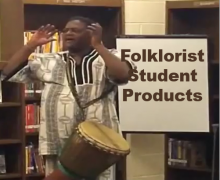This lesson is for : Grade 6:
Summary
This lesson is taught at the end of an in-depth unit- Into the World of Folkloristics. During this unit, students explore the field of folkloristics, specifically the oral branch. Authentic roles of professionals in the field are thoroughly investigated, researched, and tried out. These roles include storyteller, literary teller (an individual who writes folklore), and a folklorist (an individual who analyzes, collects, and organizes folklore). Ultimately, students use personal reflection to choose a specific professional role to specialize in. After the role has been chosen, students create a final product to showcase the role. There are five different product options to choose from. After students finish their products, they share their work during a folklore festival. This lesson specifically focuses on student product development.
TIPC Ratings
Research & Information Fluency
Rating: Ideal – Explanation: This lesson is built around students performing research and practicing information fluency skills. During the lesson, students specialize in an authentic role of a professional in the field of folkloristics. Each of the student product options include a research component. Students rotate to different stations during their work time. At one station, they work independently on their research using digital and print resources. They also work on the development of a final product using the information they have uncovered. A few of the possible product mediums include PowerPoints, Prezis, Piktocharts, videos, posters, written stories, and performances. At another station, students work collaboratively with peers and provide constructive peer feedback. At the third station, students work in small groups with the teacher. The teacher acts as the facilitator, provides feedback, reteaches necessary concepts, and answers student questions. The teacher will use an independent work skills rubric to formatively assess students throughout rotations.
Communication & Collaboration
Rating: Ideal – Explanation: Communication and collaboration are essential parts of this lesson. In order to complete their projects, students will work both independently and collaboratively. Students will give and receive constructive feedback to peers, using Google Docs for making suggestions. The teacher will also work closely with students, providing them support and facilitating the lesson. After students complete their projects, they will personally reflect by assessing their work using a teacher generated rubric. The rubric will be provided to students at the time projects are assigned. The teacher will also use the same rubric to formatively assess students. The teacher will conference with each student and discuss the students rating, as well as the teacher’s rating, establishing future work goals. Also, part of each student’s project includes presenting their work in front of an audience of peers and parents at a folklore festival. Students will present using various mediums (such as PowerPoints, Prezis, Piktocharts, videos, posters, written stories, and performances), and they will practice communication skills that were modeled earlier in the unit when a professional storyteller performed for the class.
Critical Thinking & Problem Solving
Rating: Ideal – Explanation: Each of the five project options incorporates critical thinking and problem solving components that are relevant to authentic roles of professionals in the field of folkloristics. For example, folklorist product option 3 prompts students to analyze the current ATU typing system that is used by folklorists for the classification and organization of folklore. Students must determine the system’s strengths and weaknesses, propose a way to improve the system, carry out the changes, and analyze results of the change. Additionally, for all of the projects, students will use digital and print resources in order to answer essential project questions and gather data that is needed in the development of their project.
Creativity & Innovation
Rating: Ideal – Explanation: This lesson heavily incorporates creativity and innovation. Each of the products that student specialize in require the use of both of these skills. Examples include creating original folklore (literary teller), performing folklore (storyteller), designing the introduction to the classroom anthology [which will showcase student work and be distributed to all students] (folklorist), developing a cultural festival product to showcase cultural elements analyzed in two different pieces of folklore (folklorist), and developing improvements to the ATU typing system (folklorist).





